
“She Was Born For This”; A Family-Run Charter Hits The Right Notes In Homer
The following appeared in the August issue of Alaska Sporting Journal:
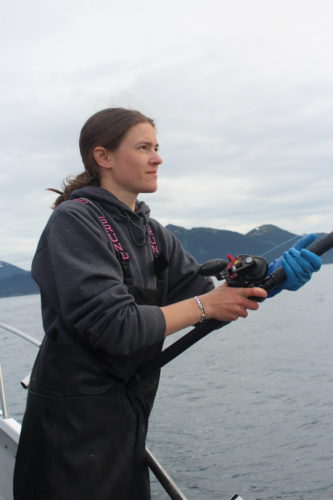
BY DAVE ZOBY
Capt. Shannon Zanone steered the Snow Goose II in the light chop between Elizabeth and Perl Islands. We already had our halibut limit of two fish apiece, and now we wanted to round off the trip with limits of rockfish.
Shannon scanned her electronics and checked the depth: 156 feet. Six of us, all men in our 50s and up, stood on the deck and waited for her to make the call. Deckhand Ciara Lambert – “C” as she is known in the fleet – had switched us over from heavy halibut gear to lighter jigging rods with spoons.
“OK; drop ’em,” said Shannon. I watched as my silver jig disappeared.
In the distance I could see the Barren Islands, and further still, Mount Augustine, a semidormant volcano which rises out of the sea.
“The other day it was 8-foot swells out here,” C told us. “We wouldn’t be out here in that.”
Jigging for rockfish in these remote areas – we were 40-plus miles out of Homer – is a fast-paced and exciting style of fishing. You never know what you are going to pull up. The limit is five rockfish, only one of which can be nonpelagic. And though we had doctors and financial whizzes on board as clients, none of us really knew much about which species was which.
C told us to make sure we kept track of our fish ourselves. She set out – a blur on the deck – releasing fish into the fish hold, untangling lines and marking fish so the clients would know which were theirs at the end of the day.
Shannon reset the drift, making sure we went over the pinnacles that surge up from the sea floor in dramatic fashion. Occasionally, she called out our depth. She ran back and forth between the captain’s chair and the deck. I peeked at the screen to see blips of blue connoting schools of rockfish.
While reeling up a rockfish, I felt a heavy jolt on the line. The drag sang a bit.
“Color!” I called out. But I wasn’t sure what I was seeing: A huge lingcod – C later estimated it to be well over 40 inches – twisted in clear water beneath the Snow Goose II. The quillback rockfish shed scales, but otherwise had accepted its fate.
“Whoa. Shannon, come see this,” said C. The lingcod swam with the rockfish in its jaws.
I haven’t kept a lingcod in over five years; either I can’t catch any or, when I do, they are out of season; or the ones I catch in season are under the 35-inch minimum. Lingcod season was closed when I fished with C and Shannon, so there was nothing to do but watch as the ling tenderized my quillback. After chewing on my fish, he let go and spiraled into the depths.
C explained that June is when these fish spawn and they are more aggressive. As the summer goes, lingcod become harder to catch.
“When I was running the boat last year I had my sister, Callie, as a deckhand,” C said. “With lingcod, I told her ‘If it scares you, kill it.’ Those things are prehistoric.”
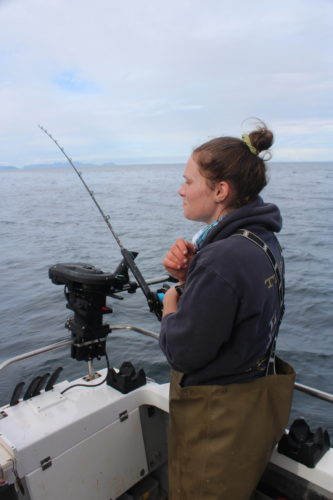
AFTER LIMITING OUT ON rockfish, we took photos of the deck awash in fish, then headed back to town. Shannon said she’d stop if she saw any whales. After all, like many of the upstart captains I have met over the past seasons, Shannon began in Homer on an ecotour.
She worked on one of the larger vessels that take people to Gull Island to see the seabirds and otters. Daily runs to Seldovia, and the occasional humpback sighting left her wanting more. Shannon drifted to the high-octane lifestyle of charter fishing, where no day is like another.
Fishing 100 days straight in all types of conditions with all types of clients, she found her home working as a deckhand under David Bayes on the Current Lady, one of the more modern, high-tech boats in the Homer harbor.
“I took my captain’s course over the winter and I was planning on just deck- handing for another year. But then the captain for this vessel fell through. I was asked if I would step up,” said Shannon. “This year it’s a lot more of a mind game thinking through the different aspects of the tide and the weather. Thinking through the entire day, from top to bottom, is something I’ve never done before. I touch a lot less fish, which is kind of disappointing, but I really enjoy this part of it.”

SHANNON DESCRIBES HOMER AS a close- knit community, where women coming up as deckhands are encouraged to take their captain’s course.
“We had a couple of female captains start like five to eight years ago – they did a really good job. People were really impressed with them, so it paved the way for the rest of us to jump on boats and do the same thing with little to no hesitancy,” she said.
She rattled off a series of boat names and their female crews. The phenomenon of female crews in Homer isn’t a gimmick (Alaska Sporting Journal, March 2022). Perhaps it comes off as a curiosity at first, but when you see the hauls of fish brought in by all-female crews, and you hear other captains sing their praises, you begin to understand that this trend is here to stay.
“The Legacy is an all-female crew this year. Faith. Mickie. Chelsea. Ayjan. Me. Ciara is going to be running the Sweet T eventually. I think there are at least eight female captains this year,” she said.
I watched in amazement as C filleted piles of Pacific cod, halibut and rockfish. She had her earbuds in and I felt like I shouldn’t disturb her with journalistic pursuits. So I just watched. We all did. The three brothers from Colorado were heading off to fly fish in Bristol Bay. The other two men were making overtures to returning and booking with Shannon and C.
Shannon navigated and called Homer Fish Processing to tell them we were coming in with a full load. The end of the day is always bittersweet because you’ve looked forward to the trip all winter, and now, you are fish-rich, but the day is gone.
When C was finished cleaning fish, she power-washed the deck and stared at the ocean. She told me that the other night she had cooked a whole quillback tempura-style, dipping it in a simple sauce of ginger, sesame and soy sauce. She said she likes to eat fish fresh, never freezing them. Then her face lit up.
“Have you ever had rockfish ceviche?” she asked. “You have to try it.”
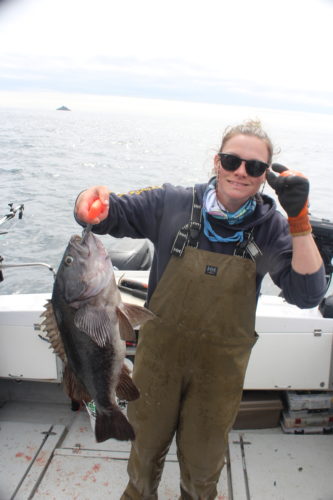
LIGHT POURED INTO THE Green Can, a new bistro-style restaurant that specializes in local seafood and craft cocktails. From the expansive windows you can see the whole splendor of Kachemak Bay. In the distance, charter boats were speeding back to the marina.
Though I was suffering from dock- rock from being out on the water all day in flat seas, I met the owners of D&G Charters (907-435-4019; homerhalibutfish.com), the people who hire and support Shannon and C. Garrett and Deziree Lambert started D&G over seven years ago as a family-run business. Garrett is C’s big brother.
Currently, they own two charter boats, the Snow Goose II being one of them. Four of Garrett’s sisters work as deckhands and captains. One can only imagine how their dinner conversations must go during the busy season. Garrett said people like Shannon and his sisters excel in people skills, are patient with customers, and are quick to master the fishing techniques made difficult by enormous tides and iffy weather.
“A lot of captains right now started off as deckhands. So you think about where we were eight, nine, 10 years ago – everyone here was green to the industry. A lot of those people are vessel operators right now, boat owners,” Garrett said. “Everyone started bottom and worked their way up. And there were a handful of girls that tagged along with their brother, or family member, or friend from college. Because it looked like a fun time. But it turned into a leadership fishing role.”
He described how he and C came up and entered the industry, first in Ninilchik, and then in Homer. All their life, Garrett would take C along on adventures: duck hunting, bow fishing, Alaska. He said that when she came to Alaska, she immediately took to it.
“She was born for it,” Deziree said.
The Lamberts say that their business was doing well, but when C joined fulltime and began captaining, things really took off.
“You got to understand, Ciara, Shannon, Chelsea – all of the women in the industry – are so attentive to detail,” Garrett said. “While we’re having a good time talking to you, we’re counting down – ‘Eight minutes from now I need to head to the third finger for my slowdown. I need to be there by 9:47.’ They’re so dialed in while fishing that it’s an enjoyable day. We live and die by the tides. So it’s very easy to make the fishing look easy, or look impossible.”
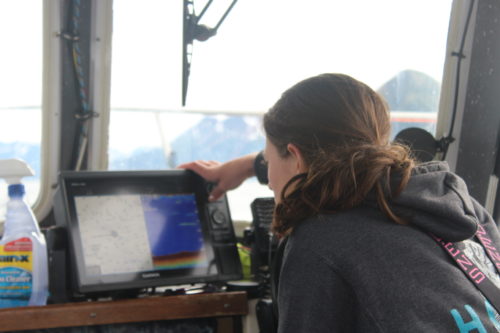

THE LAMBERTS ARE THE quintessential Alaskan couple. Young and fit, they are quick to compliment the community of fellow charter boat owners who support them. Deziree ordered king salmon and various dishes representative of Kachemak Bay.Thechefstoppedintosayhello.
Garrett runs a charter boat in the summer and transports hunters to remote areas in the fall. Deziree, who says she will go fishing once or twice
a year, markets the operation onshore with her gracious people skills. Before meeting Garrett, Deziree was “straight from Atlanta; pumpkin-spiced lattes and heels.” She had never fished or shot a gun before she fell in with the Lamberts.
“D&G is very word-of-mouth. So everyone who comes on our boat turns into family. Our business is probably 90-percent repeat. The 10 percent that is not repeat, that is new, that kind of found us on Google, or whatever the case may be, they’re coming out looking for an experience,” said Deziree. “They don’t really care about the size of the fish. They want to get out. And they love the female captain/crew. They see it on Instagram and see it’s really fun.”
She feels immensely satisfied when she hears that clients had a good experience and want to rebook with Shannon and C.
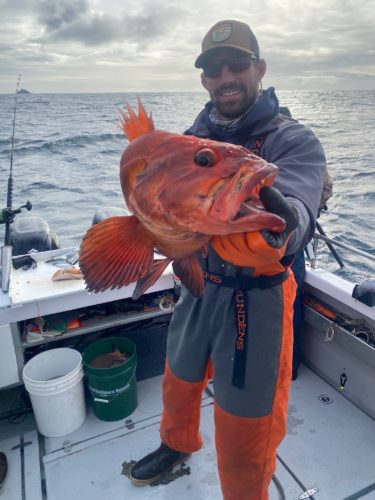
The Lamberts also described a changing clientele. They said more and more professional groups – sports teams, healthcare workers, female organizations – are booking with them. International bookings pick up during the shoulder season. They say the fall can be wide-open fishing with “exiting” halibut and massive schools of baitfish. Things slow down in Homer, but the Lamberts keep going.
D&G offers a “laid-back” king salmon/crabbing trip in the winter and spring. Garrett and Shannon will team up and take clients. Sometimes C captains the boat.
“You have the whole place to yourself,” said Garrett, “Most of the stuff is half-price, as far as lodging goes. All the fish are here; we just don’t have anyone to catch them.” ASJ
Editor’s note: Dave Zoby is a freelance writer out of Casper, Wyoming, and the fly- fishing editor at Strung Magazine. Follow him on Instagram (@davidzoby).



